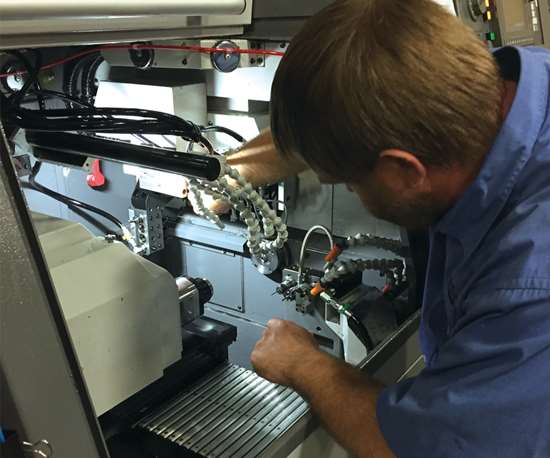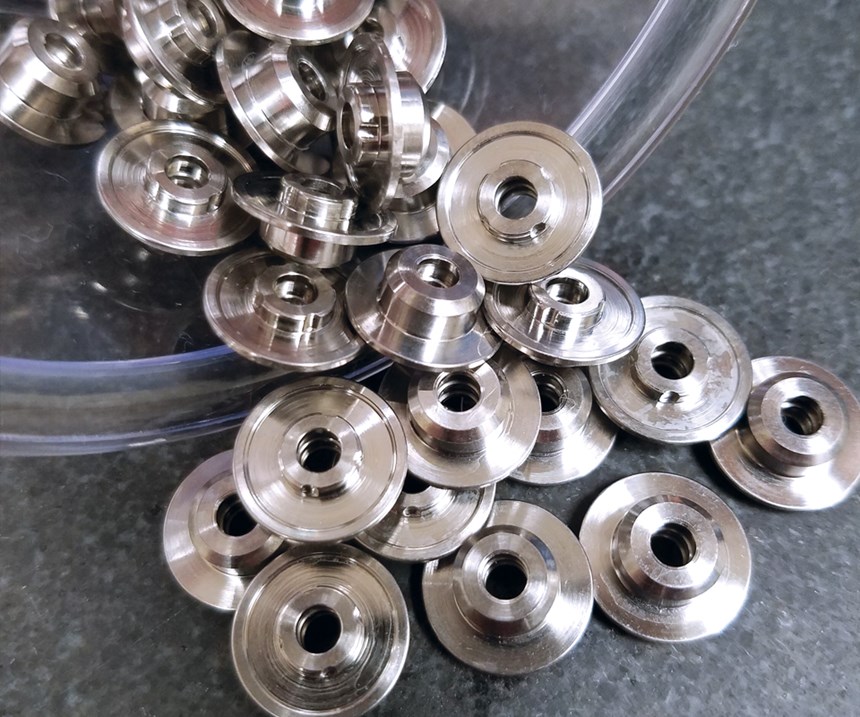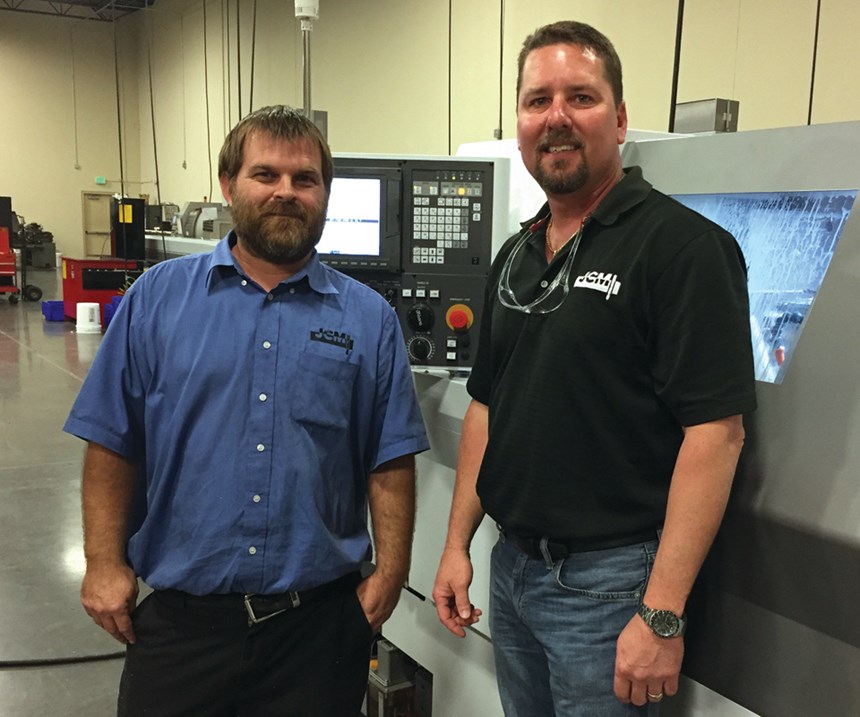Moving into Medical Machining
A background in aerospace manufacturing provided this company with the skills it needed to begin medical machining.
Market diversification is central to protecting a company’s bottom line: If there is a downturn in one area, others will be stable, thereby mitigating any related loss of revenue. That’s why most machine shops are constantly on the lookout for opportunities to enter new markets. Using existing expertise and capabilities as leverage is one way to determine the best market to pursue. Are there similarities between parts you’re already producing and those you’d like to produce? Does your process knowledge form a strong enough foundation to build upon if learning new machining techniques will be required?
These are only a couple questions JC Machine Inc.’s management pondered when considering entering the medical market about two years ago. With roots in making parts for the chemical and phosphate industries, over the years it had expanded into electronics, robotics, defense and aerospace. As a precision machining job shop, it had developed a reputation for seeking out challenging work involving small parts with tight tolerances. So when the opportunity to quote on a series of medical parts arose, the decision was made to pursue it rather than consign it to the no-bid file. Not only did the company win the bid, but in the process it may have changed the character of the company, as well as its path moving forward.
Featured Content
Opportunity Arrives
Based in Lakeland, Florida, JC Machine Inc. (JCMI) was founded in 1967. A family owned business now in its third generation, Jay Creasy is its president and his father, John, is vice president and CFO. The company employs about 35 individuals in total. In 2014, it relocated to a new 30,000 square-foot facility, which includes adequate property for future expansion.
For the company’s aerospace parts work, two Polygim Swiss-type lathes were purchased to produce faster components. Both machines were 20 mm with milling capabilities and a subspindle, with a programmable B axis for additional dexterity in machining hard-to-reach features. This was the company’s introduction to Swiss turning.
Aware of its expertise in precision machining, and especially its excellent track record in a demanding market such as aerospace, a medical device manufacturer approached JCMI about producing surgical tooling for a job it needed to complete. Mr. Creasy says there was already the desire to expand the Swiss turning side of the business, and that the process was a natural fit for medical machining, so it had already occurred to him that the opportunity held a lot of potential.
The challenges of transitioning into medical involved delving deeper into Swiss-type turning, working with unfamiliar materials such as 440 stainless steel, identifying the right tooling for the job, developing the skills required for making cuts involving extreme transitions in the depth of the cut and while working near the guide bushing to maintain workpiece rigidity. The benefits, apart from creating a new revenue stream, included entering a vibrant field with frequent technological advances, such as robotic surgery, constantly creating a demand for new types of parts.
After weighing the pros and cons, JCMI quoted the job and eventually landed it, building on the relationship so that it’s now producing four families of parts with as many as 10 parts in each family.
Learning Curve
First, there were a couple of hurdles to clear, such as identifying the right machine tools for the job. A longtime relationship with Page Spinetti, president of SwissTech Machinery in Orlando, Florida, which represents Marubeni Citizen-Cincom, led to the purchase of two Swiss lathes: an L12 Type VII and an L20 Type IX, both with milling capabilities, a subspindle and 2,000 psi high-pressure coolant systems for chip clearance and heat dissipation. Mr. Creasy chose the L12 in order to produce smaller diameter precision components and to reduce cycle time by utilizing a smaller work envelope, reducing the point to point travel distance. The bar feeders were also supplied by Citizen, and ground barstock is used for all medical parts.
The next challenge involved working with 440 stainless steel and its different alloys—a hard material that can be difficult to machine. SwissTech again proved to be a valuable partner, working with the company to identify the right tooling for the job—a critical decision involving the material and design of the tooling, as well as coatings that both protect the cutting edge and provide the desired workpiece surface finish. Finding tools that would deliver the right finish while also handling the various and abrupt changes in the depths of cut that medical parts require were factors Mr. Creasy says had to be taken into consideration. It was also important to explore different chipbreaking features that would complement the high-pressure coolant system in keeping the cut clear of chips and avoiding longer chips that might tangle and create bird’s nests. A customized list was finally developed of specific tool geometries and coatings that aid in chip evacuation and improved surface finish to eliminate secondary finishing operations.
Medical parts, especially the “tool blanks” JCMI is producing that are a maximum of 2 inches in length and up to 0.196 inch in diameter, often feature abrupt changes in depths of cut, requiring tooling that can make a 0.004-inch cut and plunge straight into a 0.080- or 0.090-inch cut and still achieve the required surface finish.
Mr. Creasy assigned one of his CNC machine operators to oversee programming of the four lathes that make up the company’s Swiss department. Craig Fancher, Swiss lead machinist, had never performed Swiss machining, which he found beneficial because he didn’t have anything to “unlearn.” He knew enough about standard CNC machining to immediately realize that an operator has to approach Swiss machining in a completely different way because of factors such as making a variety of cuts in one pass, and how the tools to address the workpiece. An advocate for “learning things the hard way,” Mr. Fancher decided to write his code by hand rather than using software. This way, he would be more deeply immersed in the entire process and found it helped him begin thinking differently about machining. He says while grooving and ID work are relatively simple to program and machine, profile finishing can be more intricate and sometimes requires a unique approach when close tolerance parts are produced using Swiss machines versus conventional turning centers.
In addition, JCMI pays close attention to its customer’s exact specifications, meeting them without exceeding them and racking up unnecessary costs. The company also tries to avoid control plans issued by its customers’ quality engineers that are so detailed that they bog down the ability to get the job done. Mr. Creasy says each part is examined for manufacturability and no more. He finds this type of approach central to a manufacturing engineer’s responsibilities to the customer.
Benefits Abound
The company’s cautious approach to entering the medical parts market has served it well, resulting in new customers and increased revenue. Beginning by producing relatively simple parts has given management time to work toward more complicated components, such as implants, often made of titanium and with demanding, complex geometries. Productivity is higher as well, with Mr. Fancher running the four Swiss machines during his shift, setting them up to run unmanned—with the occasional check during the second shift, and then in lights-out mode over the weekends. JCMI also plans to offer grinding of medical parts in the future.
Mr. Creasy says he’s seen beneficial shifts in both the company’s philosophy as well as its structure since adopting Swiss machining. He says learning a new machining process that is so different from traditional CNC machining has forced him to think differently about every aspect of the company’s operations, and he encourages all of his employees to do the same.
He has also found that conversations between Mr. Fancher and other operators have led to new approaches to machining that simply wouldn’t have occurred before Swiss turning was part of the company’s mix of capabilities. For instance, a vendor may suggest that a particular cutting tool should ideally be run at a certain speed, but the operator might find that the “sweet spot” is actually much higher, in terms of surface feet per minute.
Mr. Creasy has also taken the opportunity to rethink JCMI’s production profile, dividing its offerings between a high-volume production area and the job shop area, and producing relatively low quantity orders machined on the Swiss lathes. Not only has this streamlined production, it has made it easier to discuss potential jobs with customers since the two approaches to manufacturing are so distinct.
As is often the case, adopting new technologies has awakened everyone at JCMI to the fact that complacency can sometimes begin to overshadow creativity if you believe there’s only one way to machine a part. The exercise of learning a new machining process can awaken a sense of curiosity about how everything on your shop floor is being done, and how it could be improved. And the increased level of morale in workers who are being challenged, and seeing their ideas put into practice, is the fuel that propels any company forward.
For more information from Marubeni Citizen-Cincom Inc., call 201-818-0100 or visit marucit.com.
For more information from JC Machine Inc., call 863-644-2815 or visit jcmi-usa.com.
Sidebar: Hands-On Experience Bolsters Academic Endeavor
Jay Creasy is a big believer in academic outreach. As president of a successful machine shop, he feels a sense of responsibility when it comes to contributing to the future of manufacturing in the United States. He visits local high schools and community colleges to speak with students about the career opportunities that exist in manufacturing, also holding a Manufacturing Day event each year providing local students with guided tours of the shop floor. He wants them to understand that the grimy environment many people envision has been replaced by clean machine shops featuring high-tech machine tools with a steady supply of challenges to overcome. He’s not interested in a hard sell, but instead hopes to make students aware of the current manufacturing realities.
Mr. Creasy is chairman of the Polk Engineering Technologies Education Council (PETEC) and a member of the Polk State Cooperate College Advisory Board. The college offers a CNC machining class in its new Advanced Technology Center. The program recently graduated its first class of eight students, of which JCMI has hired four. In addition, he currently has two fourth-year engineering students working as interns, augmenting their classroom learning with real-world experience operating machine tools and inspection equipment. This, he says, will make them better engineers.
It’s one thing to be aware of and concerned about the current skills gap, and another to actually get involved in seeking out a solution. His example is not only good for the students he connects with, but for all of us who want manufacturing not only to survive, but to thrive.
RELATED CONTENT
-
Manufacturing Data Collection and Management Transforms Swiss Shop
A New Hampshire high-volume precision solutions manufacturer and an innovative software solutions provider have collaborated in upgrading the shop’s data collection and organization methods, maximizing output and competitiveness.
-
Dry Swiss Machining in Medical
Continuing to build its reputation for creative solutions, this multi-faceted medical device component manufacturer took its Swiss machining operations to a new level to meet a customer’s market demands.
-
How to Get More Efficient Production from Swiss-Type and Multitasking Machines
SolidCAM for multi-axis Swiss type and multitasking machines provides a very efficient CAM programming process, generating optimal and safe Mill-Turn programs, with dramatically improved milling tool life.









